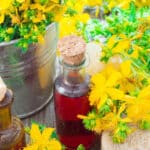St. John’s Wort For Pain, Seasonal Depression & More
This post may contain affiliate links. Read my full disclosure here.
St. John’s Wort (Hypericum perforatum) is a soothing, and healing nervine. It relieves pain and treats nervous system problems like neuralgia, coccygeal pain, rheumatic and arthritic pain, and nerve injuries. St. John’s Wort is also a potent healer for wounds, bruises, burns, sprains, and muscle pain. Additionally, it helps to manage conditions such as anxiety, seasonal depression, and more.
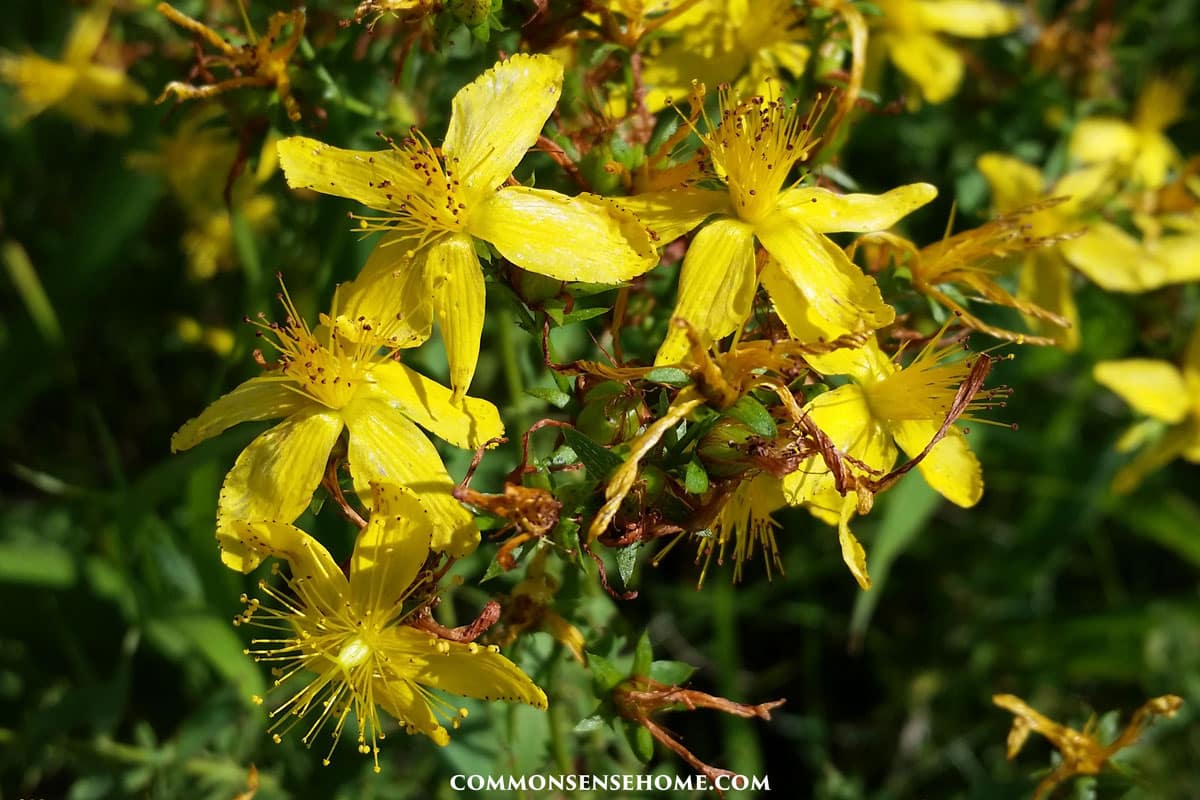
We’ll share how to forage, grow, and use St. John’s wort, plus two must-have preparations for your home apothecary.
Origin
There are approximately 400 different varieties of Hypericum, with H. perforatum specifically recognized as common St. John’s Wort.
Its widespread nature makes it challenging to pinpoint its exact origin. The variation Hypericum perforatum may have originated from Europe, North Africa, and Asia. The name “St. John’s Wort” reflects the plants’ tendency to bloom in late June, coinciding with the annual feast of St. John.
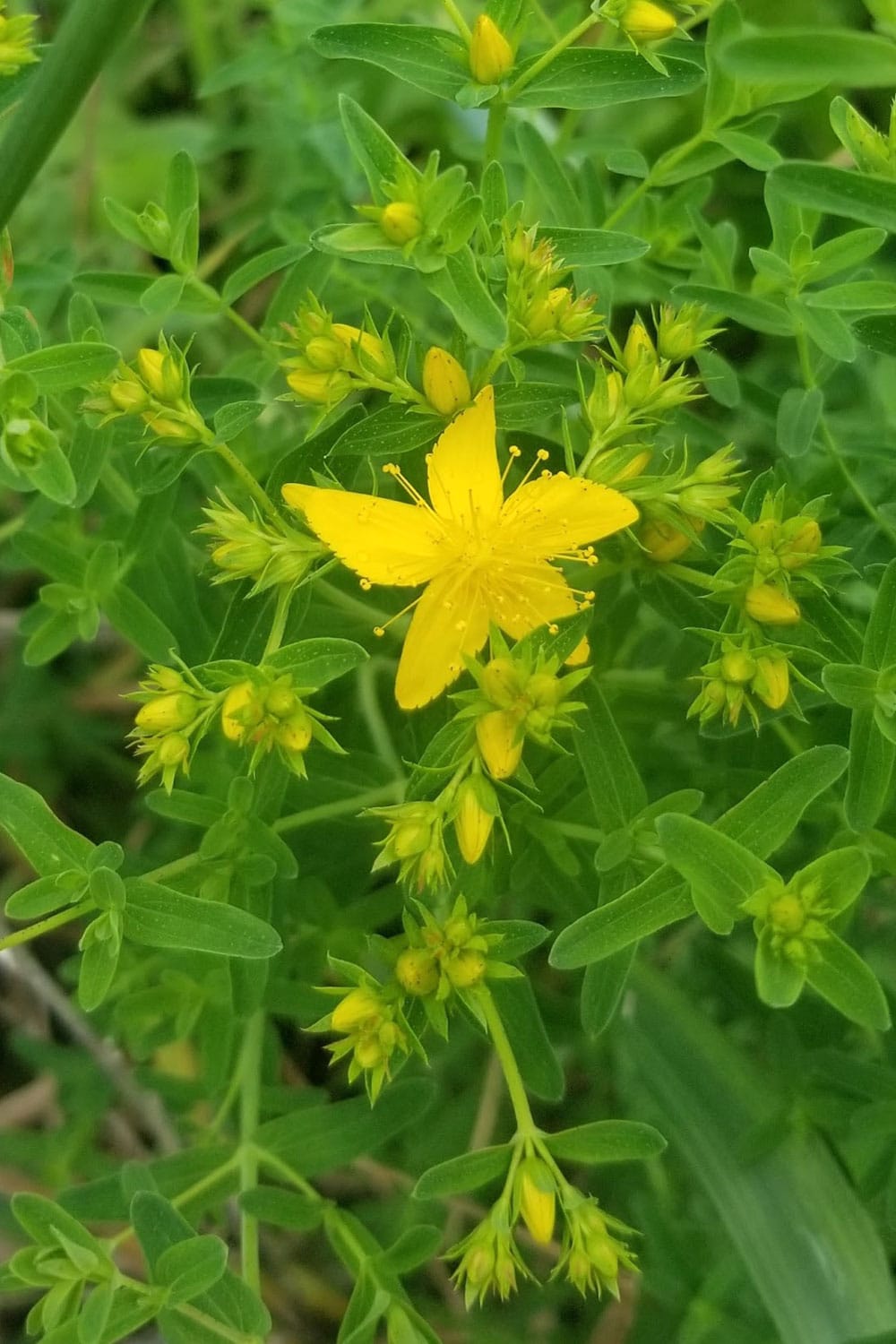
Identification for Foraging
St. John’s Wort is a sprawling perennial with yellow flowers that grows between 1 to 3 feet in height. A common “weed” in much of the United States and elsewhere, it readily spreads by both rhizome and seed. It grows in full sun to part shade along roadsides, field edges, and areas of disturbed soil.
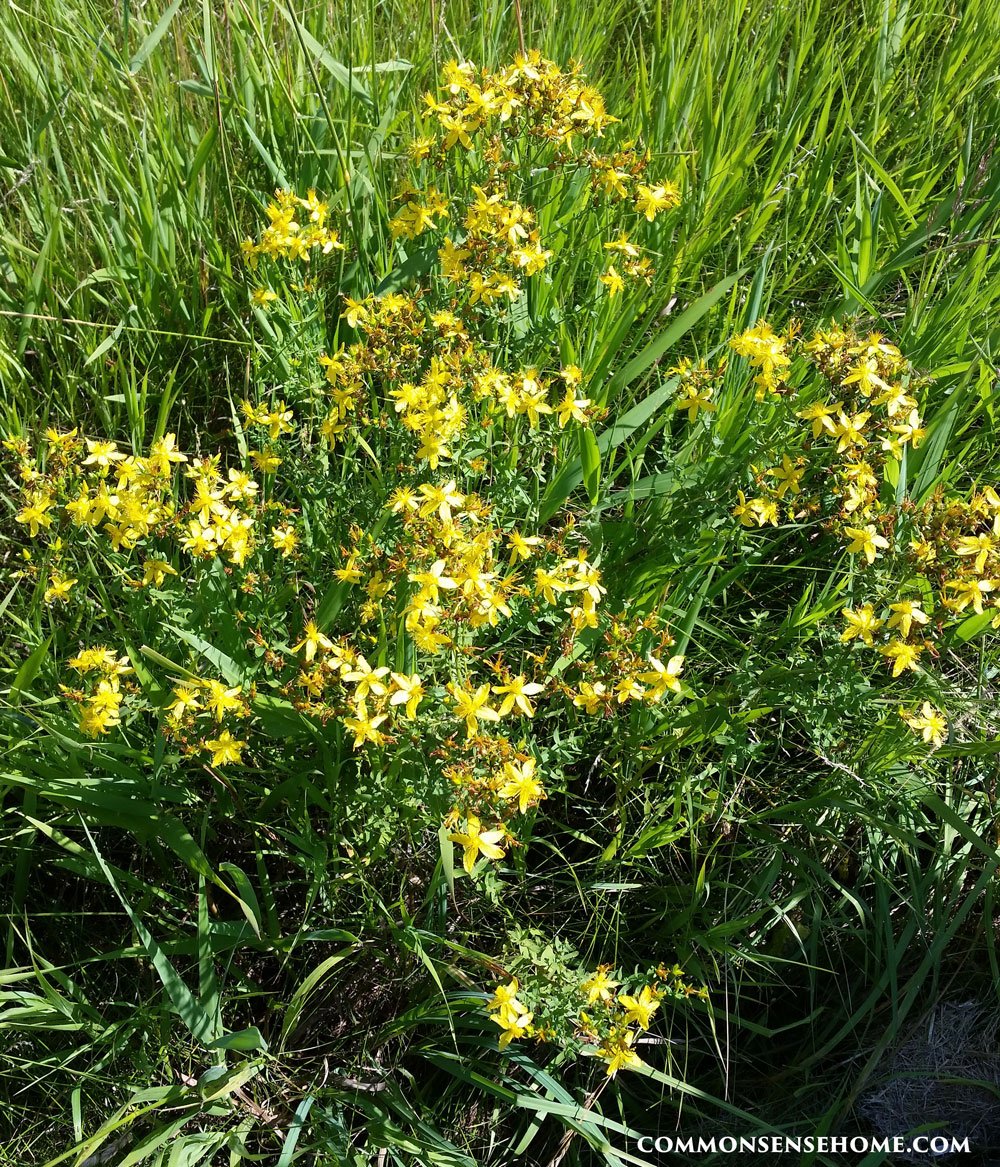
St. John’s Wort produces small yellow flowers clustered at the top of the plant. These flowers feature five petals with tiny black dots along the edges and numerous stamens. They release a red stain onto your fingers when crushed.
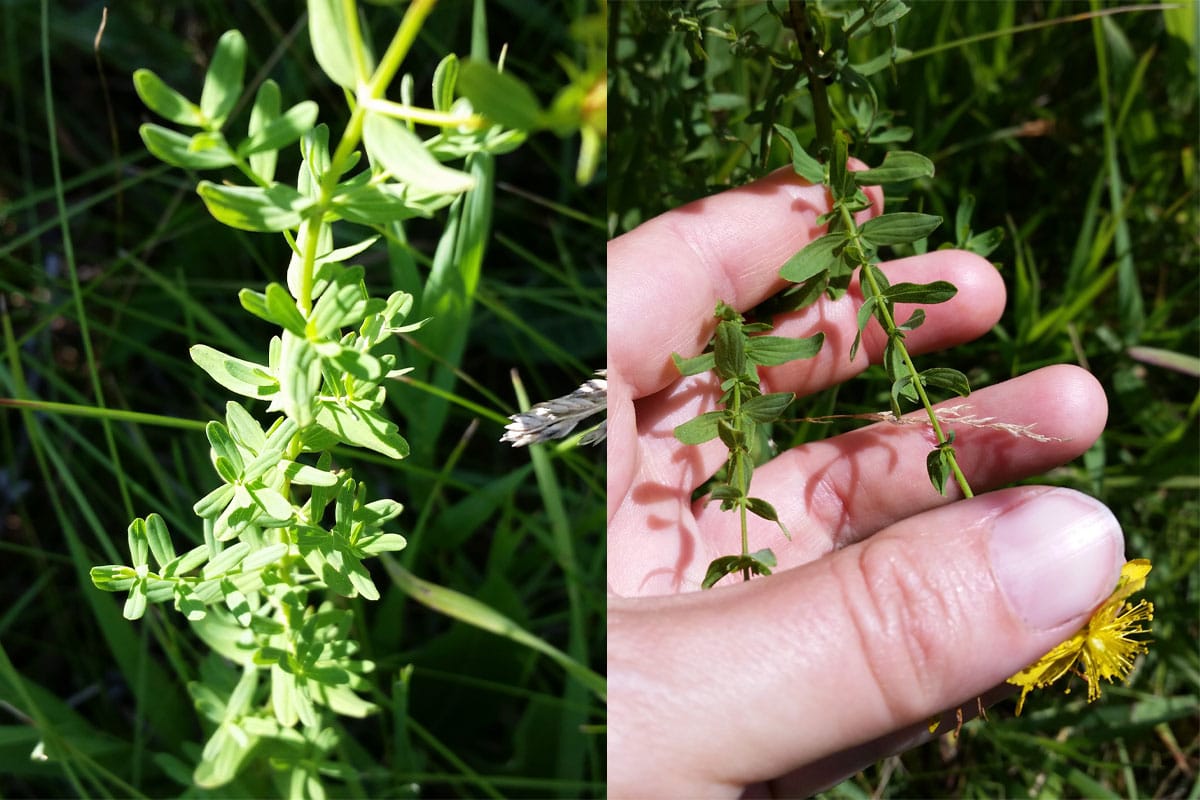
The leaves are stalkless and narrow, they grow opposite along the stem, and have rounded edges that have tiny transparent dots. Sometimes there are black dots on the underside.
Cultivation
St. John’s Wort is a low-maintenance shrub suitable for landscaping and rock gardens. It can thrive in various soil types, and will spread to up take as much space as you allow.
The optimal time to plant it is in mid-spring (March to April) or in the autumn (September or October). Plant any time of the year, as long as the soil is workable.
Planting
Start St. John’s wort either inside from seed, or direct seed outdoors. Outdoors, plant seeds 0.5 m apart in early spring to late autumn. Be sure to mark your plantings.
To start inside, provide a heat mat until the seeds sprout, and then provide a light source. In either case, keep plants consistently moist, but not overly wet, until the second set of leaves have emerged.
Transplant
The best way to transplant St. John’s wort from the wild is to dig the plant in either early spring, or late fall when it is not in active growth. Select a location with partial sun, and dig a hole roughly twice the size of the plant’s root ball.
Settle the plant in at the same depth it was growing, add a little organic fertilizer, and backfill with soil. Keep the plants watered thoroughly until it is well established.
When to Harvest
Harvest St John’s wort when it’s in full-bloom, in the late morning when the dew clears. If the red stain releases when you crush the flowers, they are at their medicinal peak and ready to harvest.
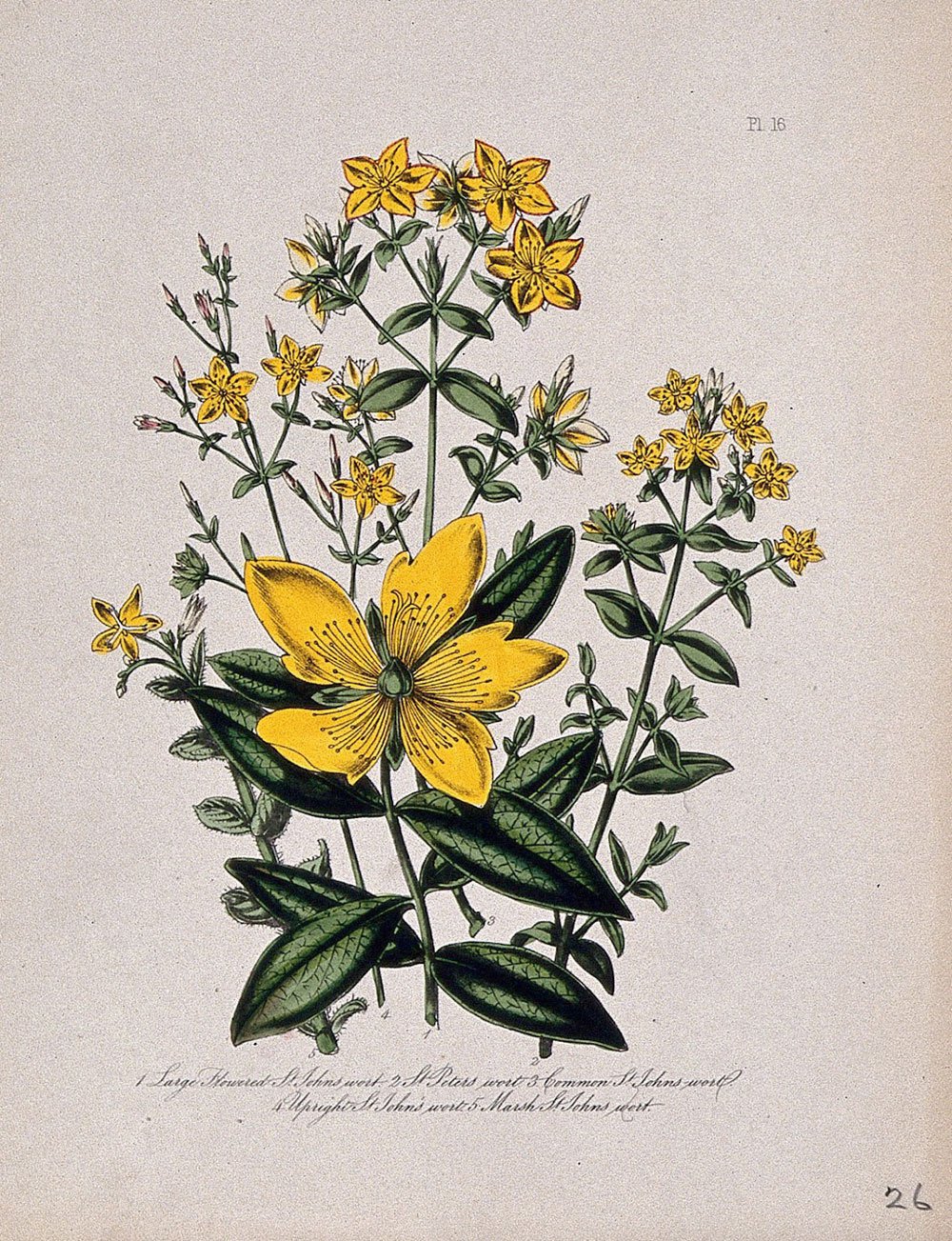
Uses of St. John’s Wort
St. John’s wort has a history of use for “melancholia” and warding off “evil influences.” Modern research has confirmed its effectiveness in addressing what we now understand to be certain mental health conditions.
Traditionally, it is used topically as oil, salve, or poultice for healing wounds, burns, and bruises. Moreover, it is effective in alleviating muscle pain, sprains, and addressing various inflammatory conditions, including damaged nerves, neuralgia, sciatica, shingles, and rheumatism. Other historical uses include treating eye problems and respiratory issues.
Actions of this herb include:
- Analgesic
- Anti-inflammatory
- Antidepressant
- Antimicrobial
- Antiseptic
- Antispasmodic
- Antiviral
- Astringent
- Antibacterial
- Diuretic
- Nervine Stimulant
- Tonic
- Vulnerary
St. John’s wort is recognized by the red stain – hypericin, that is released when its yellow flowers are crushed. Hypericin contains antibacterial, antioxidant, and antiviral properties.
St. John’s Wort for Mental Health and Seasonal Affective Disorder (SAD)
St. John’s Wort helps to ease anxiety and tension, promoting an uplifted spirit. Researchers have extensively studied it as a treatment for depressive disorders, as well as other mood disorders.
St. John’s Wort can influence, counteract, or regulate and balance brain chemicals like gamma-aminobutyric acid (GABA), serotonin, dopamine, and noradrenaline.
This capacity to normalize GABA levels in the brain may be how it calms anxiety and relieves depression.
Seasonal Affective Disorder (SAD), also known as winter depression, is caused by reduced sunlight. Studies indicate that St John’s wort combines well with phototherapy for those who experience depression to improve mood.
Herbalists suggest that St. John’s wort be taken for several weeks to see the best results. Begin therapy begin in late autumn to ensure effectiveness during the darker months. Learn more about tips to help fight seasonal depression.
Preparations
St. John’s wort internal and external preparations include:
Would you like to save this?
- Tincture
- Infusion
- Infused oil
- Salve
- Liniment
I recommend having a few basic St. John’s Wort preparations in your apothecary. Below, you will find recipes for a simple herb-infused oil and a basic tincture. Both the tincture and the oil will become a beautiful deep red in color.
St. John’s Wort Infused Oil
Ingredients
- Fresh St. John’s wort flowers, and leaves taken from the uppermost portion of the plant
- Olive oil
Directions
- Chop the flowers and leaves and fill a sterilized glass jar ¾ full.
- Cover the herbs with olive oil so there is an inch above them, and seal with a lid.
- Allow the mixture to infuse on a sunny windowsill for at least 3 weeks. Press down the herbs a few times per week to keep them covered by oil.
- After three weeks, the oil should be a deep crimson color. Strain it through a cheesecloth or a fine mesh strainer into a clean, dry container.
- Transfer the strained oil into a glass bottle or jar. Dark colored jars help protect the oil from light, which can cause it to degrade.
- Label the bottle with the name of the infused oil, the date it was prepared and any other information you want to add
- Store the bottled oil in a cool, dark place to preserve its quality. Avoid exposure to direct sunlight.
Use for external application as needed.

St John’s Wort Tincture
Ingredients:
- Fresh St. John’s wort flowers and leaves (harvested when in full bloom)
- At least 190 proof vodka or grain alcohol
Equipment:
- Clean glass jar with a tight-fitting lid
- Cheesecloth or fine mesh strainer
- Dark glass tincture bottles for storage
Directions:
- Chop the flowers and leaves into small pieces. This increases the surface area and helps in the extraction process.
- Pour the alcohol over the herb
Use a 1:2 ratio for fresh herb, which is ideal (or 1:4 or 5 ratio if using dry herb)
- Seal the jar tightly with a lid and place it in a cool, dark location, such as a cupboard or pantry.
- Shake the jar gently every day for 4 weeks to facilitate the extraction process.
- After 4 weeks, strain the liquid through cheesecloth or a fine mesh strainer into a clean bowl or another jar.
- Squeeze the plant material to extract as much liquid as possible.
- Pour the strained liquid into dark glass jars or bottles for storage.
- Carefully label the bottles with the date and contents and store it in a cool, dark place.
Use 5-50 drops of fresh herb tincture, or 2-4mL dry herb tincture 3x a day to help treat depression.

Contraindications
St. John’s wort may cause photosensitivity in fair-skinned people if taken internally at high doses. However, at normal doses, this is rare.
Before taking St. John’s wort as a dietary supplement, consult with your health care provider. This is especially important if you are on prescription medication or have a medical condition. Avoid combining this herb with antidepressant medications such as selective serotonin reuptake inhibitors (SSRIs), as it can increase the risk of serotonin syndrome.
A side effect of St. John’s wort is that it induces a liver enzyme that supports detoxification. This may potentially reduce the efficacy of several pharmaceutical drugs such as:
- immunosuppressants
- anticoagulants
- antiarrhythmics
- other medications
It’s normal to feel sad occasionally, but long lasting depression is not healthy. If you are experiencing depression, especially in conjunction with the physical symptoms, consult your healthcare provider. These symptoms may be associated with other conditions such as low thyroid function.
The Home Apothecary Series
This article is part of the Home Apothecary series. Other articles in the series include:
White Willow Bark – Harvesting and Use
Ginger Root Uses & Health Benefits
Soothing Ginger Honey – Natural Remedy for Sore Throat and Coughs
Fennel Seed – Natural Digestive Aid

This article was written by Sylvia Gunther.
Sylvia studied under Rosemary Gladstar and earned the distinction of Traditional Herbalist. She then studied Clinical Herbalism through The Herbal Academy, where she continues her life long exploration of herbs.
Sylvia and her husband live in North Central Indiana. Together they raised six beautiful children.

